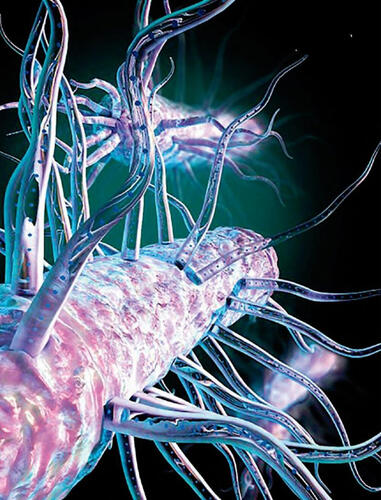
March 11, 2024
Live Wires
Living things generate electrons as a byproduct of metabolism. As humans, we get rid of excess electrons through breathing in oxygen. But not all living things breathe like us. Bacteria that live in oxygen-limited environments underground or in water, for example, need other mechanisms to “breathe out” extra electrons.
A team led by Nikhil Malvankar, an associate professor of molecular biophysics and biochemistry at the Microbial Sciences Institute at Yale West Campus, discovered that some bacteria were getting rid of electrons via “living wires.”
“We learned that these bacteria were using protein nanowires almost like snorkels to exhale electrons into soil or partner bacteria,” Malvankar says. “This means that these living wires could transmit electricity, connecting living cells to the outside world.”
The advantages and potential applications of these living wires are endless. They are biodegradable, regenerative, low cost, and function well in extreme acidic environments. With help from the Blavatnik Fund, Malvankar has found potential applications for this technology in computing, light harvesting, infectious disease treatment, body sensors, and DNA sequencing.
“We are using billions of years of evolution to our advantage here,” Malvankar says. “It’s tough to beat nature’s design.”
Malvankar says that assistance from the Blavatnik team has been essential.
“The fund is a bridge between basic discoveries and commercially viable products that companies can acquire,” Malvankar says. “Scientists aren’t trained to think about what parts of our discoveries are patentable, or what experiments need to be done to make industry leaders confident in investing in our work. Having that private sector expertise from the Blavatnik team has been crucial. Without them, my discoveries would never be able to reach people.”
External link: